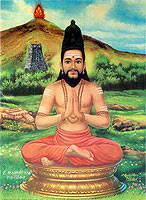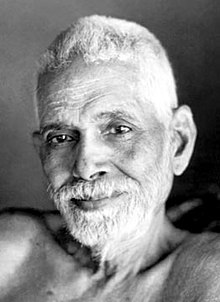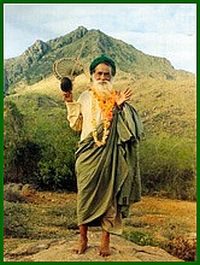Thiruvannamalai
ARUNAGIRI NATHAR
Arunagiri was born in Thiruvannamalai, a town in Tamil Nadu. His father died soon after his birth and his mother and sister instilled him with their cultural and religious traditions. Legends claim that Arunagiri was attracted to the pleasures of the flesh and spent his youth in pursuing a life of debauchery. His sister always gave whatever she earned to make her brother happy, and he frequented devadasis. There came a time when his sister had no money to meet his demands. She said that he should sell her in order to have money, upon hearing which arunagirinathar realised how selfish he had been. He decided to end his life, went to a temple and hit his head against the pillars and steps, begging for forgiveness. Then he leapt from the temple tower. He was however miraculously saved from the death by the god Muruga who transformed him into a saint.
RAMNA MAHARISHI
YogiRamsuratkumar
YogiRamsuratkumar,the Greatest saints of this era was born in a village near Kashi on the first day of December,1918.In his childhood,he loved very much to meet the yogis and monks.He was befriended by a number of holy men who build their huts on the Ganges shore or simply wander nearby.
Sri Aurobindo gave him Jnana, Sri Maharshi blessed him with tapas and Swami Ramadas gave him the nectar of Bhakti. Swami Ramadas initiated him into the holy mantra : " Om Sri Ram Jai Ram Jai Jai Ram ", by pronouncing it thrice in his ears.
Seshadri, at the age of 4, demanded the idol to perform pooja daily. Seeing the crying of the child the shop keeper himself came forward offering the doll to the child and insisted that the mother shall accept it as a gift to the child; whereby the child took it and performed poojas in his house. Next day again when they are on their way to the temple, the shop keeper came running and taking Seshadri's hands to his eyes said that the hands are 'golden hands'. On enquiry, he recited that the day he gave this idol to the child as a gift, he had such a sale that is of ten times any of his maximum sales so far in his life. It may look like having happened incidentally, but later on, the episodes in Seshadri's life at Tiruvannamalai confirmed that this incident also is of the child's power. Incidentally, the child had soolam in his left hand and a circle in his right hand; the soolam is considered as mahasakthi and the circle denotes nava graham. Coincidentally it is said that Shirdi Sai Baba also had this sakthi in his right foot.
Seshadri used to do pooja in the room for the picture of Sri.Rama, Sridevi Kamakshi and his self drawn picture of Lord Arunachala of Thiruvannamalai from the early morning to mid day bolting the doors inside even without taking food in time and even going on fast thro’out the day sometimes, inspite of his relatives advising him to eat something to maintain his health. He used to remove stones and thorns in the street at the time of Lord Narayana coming in procession from temple. He used to throw the food given to him to dogs and crows, for which he used to say that karma should pass off. Therefore some people used to laugh at Seshadri. After some time, he started going to graveyard and start penance there; even he argued with intellectuals about this penance in graveyard and won his point. Even the threatening of his uncle not to enter into their house if he does penance in graveyard did not deteriorate his determination, rather he stopped of coming to his uncle’s house; thereby, left with no option, both his uncle and aunt had to compromise to this issue, on account of their sentiments to this boy.
| Thiruvannamalai (sanskrit name for Thiruvannaamalai - Arunachala) is a pilgrimage town in Thiruvannamalai district in the Indian state of Tamil Nadu. It is the headquarters of the Thiruvannamalai district. Thiruvannamalai is home to the Annamalaiyar temple located at the foot of the Annamalai hill (also known as Aruna Giri) and amongst one of the great lord Shiva temples of Tamilnadu. Thiruvannamalai has long been associated with many yogis and siddhars. Thiruvannamalai is one of the Pancha Boota Sthalangal. The Pancha Boota stalangal’s are… * Sri Kalahasti, Andhra Pradesh representing the Air. * Thiruvanaikoil, Tamil Nadu representing the Water. * Thiruvannamalai, Tamil Nadu representing the Fire. * Chidambaram, Tamil Nadu representing the Sky. * Kanchipuram, Tamil Nadu representing the Earth respectively.
|
Arunagiri was born in Thiruvannamalai, a town in Tamil Nadu. His father died soon after his birth and his mother and sister instilled him with their cultural and religious traditions. Legends claim that Arunagiri was attracted to the pleasures of the flesh and spent his youth in pursuing a life of debauchery. His sister always gave whatever she earned to make her brother happy, and he frequented devadasis. There came a time when his sister had no money to meet his demands. She said that he should sell her in order to have money, upon hearing which arunagirinathar realised how selfish he had been. He decided to end his life, went to a temple and hit his head against the pillars and steps, begging for forgiveness. Then he leapt from the temple tower. He was however miraculously saved from the death by the god Muruga who transformed him into a saint.
Arunagiri sang his first devotional song and thereafter decided to spend the rest of his life singing in praise of the God. He was a devotee of Muruga and worshipped him at Vedapureeswarar temple at the sacred place known as Cheyyar.
His fame got the jealousy of chief minister of the Kingdom. He claimed Arunagirinathar as a false saint and not a true devotee of the god Subramaniya. So the king arranged a public gathering and asked Arunagiri to show Subramanya to others also. Arunagiri started singing songs towards Muruga and soon after Muruga appeared in a stone pillar in the form of child.
RAMNA MAHARISHI
Skandashramam
Situated a half hour's walk up the mountain is the Skandashram. It is a beautiful tree-shaded hermitage. Ramana Maharshi lived and meditated here in a cave from 1916 to 1922, and his mother attained mukti here. One can see panoramic view of the temple and the surrounding areas from here. Slightly further is the Virupaksha Cave, believed to contain the ashes of a yogi from Karnataka who lived here from 1899 to 1916. Even closer to the foothill is the Mamara Guhai (cave under the mango tree), where Ramana Maharshi stayed for a while. |
YogiRamsuratkumar
YogiRamsuratkumar,the Greatest saints of this era was born in a village near Kashi on the first day of December,1918.In his childhood,he loved very much to meet the yogis and monks.He was befriended by a number of holy men who build their huts on the Ganges shore or simply wander nearby.
Sri Aurobindo gave him Jnana, Sri Maharshi blessed him with tapas and Swami Ramadas gave him the nectar of Bhakti. Swami Ramadas initiated him into the holy mantra : " Om Sri Ram Jai Ram Jai Jai Ram ", by pronouncing it thrice in his ears.
After a Prolonged spiritual voyage,Yogiji finally reached Thiruvannamalai in the Southern India.He was seen near the Temple chariot,at the corners of the Road,under the trees of the Temple.Swamiji then began living in a small house in Sannadhi Street beneath the Temple.He continued to bless the devotees who thronged at thousands to His house at the Sannadhi Street.The Devotees wished Him to have an Ashram which He gently accepted.The YogiRamsuratkumar Ashram is constructed at Agrahara collai with a total area of 3.5 Acres.
"VISIRI SAMIYAR" as affectionately called by devotees attained Siddhi on 20.2.2001 at Tiruvannamalai in the Ashram premises
SESHADRI SWAMIGAL
Seshadri used to do pooja in the room for the picture of Sri.Rama, Sridevi Kamakshi and his self drawn picture of Lord Arunachala of Thiruvannamalai from the early morning to mid day bolting the doors inside even without taking food in time and even going on fast thro’out the day sometimes, inspite of his relatives advising him to eat something to maintain his health. He used to remove stones and thorns in the street at the time of Lord Narayana coming in procession from temple. He used to throw the food given to him to dogs and crows, for which he used to say that karma should pass off. Therefore some people used to laugh at Seshadri. After some time, he started going to graveyard and start penance there; even he argued with intellectuals about this penance in graveyard and won his point. Even the threatening of his uncle not to enter into their house if he does penance in graveyard did not deteriorate his determination, rather he stopped of coming to his uncle’s house; thereby, left with no option, both his uncle and aunt had to compromise to this issue, on account of their sentiments to this boy.
It is at the close of the year 1928 when some devotees had the ambition of conducting an abhishekam for the swamigal. The foreigners have to understand that abhishekam means pouring the pure and useful liquids, like water, rose water, sandal water, milk, etc, on the idol of a god, or goddess. At that point of time Seshadri swamigal warned the devotees that he will get fever and hinted the unwarranted consequence on account of their action. Still the people did not heed to this taking granted that nothing will happen to him being a great and powerful saint. The saint who knows the fate humbly accepted their insisting offer. Thus vessels of cold water, rose water, tender coconut water, milk were poured on his body not by a few people but the whole town took this opportunity of pouring liquids on him to show their reverence to their worshipping living god; thereafter conducted pooja to him by flowers and garlands, and applied viboothi (sacred ash) all over his body.
In the evening as the swamigal predicted, he got fever and immediately the doctors were brought to him. However, the swamigal neither allowed the doctors to attend on him nor took any food from that point of time. This position continued till 4th of January, 1929 when the swamigal joined his abode after completing his purpose with humanity. The very peculiar aspect of his samadhi was that the planetary positions at the time of his samadhi were similar to the positions at the time of his birth. His body was laid at rest at a place near Ramana Maharashi ashram; Shri. Ramana Maharishi was present then and a samadhi was constructed and a Shiva lingam was placed on this samadhi.




No comments:
Post a Comment